风沙粒度分析及沉积学特征——以伊朗中部塔巴什厄格Barchan沙丘为例
IF 3.4
3区 地球科学
Q2 GEOGRAPHY, PHYSICAL
引用次数: 0
摘要
本文研究了干旱区坝状沙丘的地质特征及风动动力学。我们分析了8个沙丘的沉积过程和粒径分布,这些沙丘相距约1公里。结果表明:粉砂(0.80%)、中砂(8.67%)、粗砂(1.34%)和极细砂(18.32%)的比例低于细砂(69.55%);关键粒度统计表明,风沙颗粒细,分选良好,平均粒径为2.64 φ,分选值为0.51 φ,偏度为- 0.05,峰度为1.26。粒度分类表明其沉积历史复杂,风成成因约占87.3%,河流特征仅占12%左右。背风坡和底部地区倾向于沉积更细、分选更好的沉积物,通常比迎风坡和峰顶地区含有更粗、分选更少的物质,因为重力沉降并影响风的运动。1986-2024年的长期风向观测表明,主要的东南方向漂移矢量是连续的西北风(RDD = 159.04°)和大量的输沙(DP = 45.25 VU)。沙流指数(0.59)表明,过渡性风沙条件在单向和多向风的作用下促进了半稳定barchan沙丘的形成。这些结果说明了沙丘形成、沉积物供应和风况之间的复杂联系。这些发现强调了风况、沉积物可利用性和沙丘形成之间存在的复杂关系。通过将广泛的沉积学研究与长期的气象监测相结合,本研究提供了对风成系统动力学的新见解,并为预测沙丘演变提供了一个实用的框架。本文章由计算机程序翻译,如有差异,请以英文原文为准。
Grain size analysis and sedimentological characteristics of wind-blown sands: a case study of Barchan dunes in the Erg of Tabas, central Iran
The current study investigates the geological characteristics and wind-driven dynamics of barchan dunes in arid regions. We analyzed the depositional processes and particle size distribution of eight dunes located approximately one kilometer apart. The results indicate that silt (0.80 %), medium sand (8.67 %), coarse sand (1.34 %), and very fine sand (18.32 %) are less common than fine sand (69.55 %). Key grain-size statistics indicate that aeolian sediments are fine-grained and well-sorted, with a mean particle size of 2.64 ϕ, sorting value of 0.51 ϕ, skewness of −0.05, and kurtosis of 1.26. The grain size classification indicates a complex depositional history, with aeolian origin accounting for around 87.3 % and river characteristics for only about 12 %. Leeward slopes and bottom areas tend to deposit finer, better-sorted sediments and typically contain coarser, less-sorted material than windward slopes and crests because gravity settles and influences wind movement. Long-term wind measurements (1986–2024) indicate that the principal southeastward drift vectors are continuous northwesterly winds (RDD = 159.04°) and considerable sand transport (DP = 45.25 VU). A transitional aeolian regime, as indicated by the Sand Mobility Index (0.59), promotes the development of semi-stable barchan dunes with both unidirectional and multidirectional wind impacts. These results illustrate the intricate connections between dune formation, sediment supply, and wind regime. These findings highlight the complex relationships that exist between wind regimes, sediment availability, and dune formation. By integrating extensive sedimentological research with long-term meteorological monitoring, this study provides new insights into the dynamics of aeolian systems and a practical framework for predicting dune evolution.
求助全文
通过发布文献求助,成功后即可免费获取论文全文。
去求助
来源期刊

Aeolian Research
GEOGRAPHY, PHYSICAL-
CiteScore
7.10
自引率
6.10%
发文量
43
审稿时长
>12 weeks
期刊介绍:
The scope of Aeolian Research includes the following topics:
• Fundamental Aeolian processes, including sand and dust entrainment, transport and deposition of sediment
• Modeling and field studies of Aeolian processes
• Instrumentation/measurement in the field and lab
• Practical applications including environmental impacts and erosion control
• Aeolian landforms, geomorphology and paleoenvironments
• Dust-atmosphere/cloud interactions.
 求助内容:
求助内容: 应助结果提醒方式:
应助结果提醒方式:


